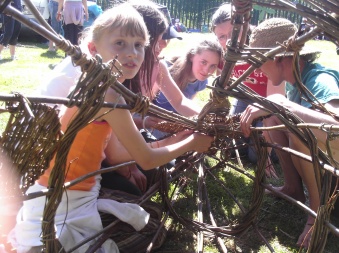
“Toledo was Wonderful” by Kate Hennessy
‘Churches were the art galleries of the Irish People’, Kate Hennessy tells me. She recalls being brought to mass on Sundays, by her respective Grandmothers, both of whom had a big influence on her as a child. Kate enjoyed the sculptures, mosaics, stained glass and woodcarvings, not to mention the tile designs these beautiful church buildings boasted in Ireland.
Kate continues to tell me that one of her Grandmothers had several religious statues under glass domes at the top of her stairs which were arranged in an aesthetic manner. The other Grandmother had a double brass bed draped in lace with statues of Our Lady, the Infant of Prague and others all creatively adorning the bed. Kate says she would love to do an installation of these memories, and I agree it would be most interesting. My own childhood was not dissimilar and I remember vividly how my dear Mother had so many statues and religious pictures all around our home at Killough. Many had been in the house from previous generations who lived there. Apart from one or two reproduced landscapes in the parlour and family photographs on the various shelves, the only art we had in Killough, when I was a child, was of a religious nature.
Early School Experiences
This theme of churches in Ireland and the role they played, by default, as gallery spaces, is continued into our discussion of Kate’s early school experiences. Of course school life in the 1950s, in Ireland, would have been deeply influenced by the Catholic Church hegemony. Kate tells me that on her first day in Junior Infants she was riveted by a huge painting her teacher, Ms Dignam had hanging over her desk.
It was of a boy and girl crossing a rickety bridge – but danger awaited them as there was a piece of wood missing on the bridge and they could fall through this gap. Some readers will remember the picture. It came into my mind immediately when Kate started to tell me the story. But the scary possibility that they might fall is redeemed by a huge Angel hovering behind the children and this suggested they were going to be protected and would get across the bridge safely.
Angels have played a big role in Kate’s artistic career. She loves drawing and depicting them and the way they emerge in different cultures and styles of art. Many of her works feature Angels like the examples here.

Angel in Mount StAlphonsus Limerick

Drawing of an Angel in St Mary’s of The Rosary Nenagh
Religious painting even sparked debates about gender in Kate’s home growing up. ‘When I was very small we had a picture of Jesus in our hallway’ Kate continues, ‘I used to fight with my brother Johnny because I thought Jesus was a girl because he had long hair in the picture. Johnny would say, ‘no, he is a boy!’. Men did not start to wear long hair in Ireland until the 60s and 70s so understandably Kate and her brother’s deliberation on the gender of Jesus, as presented in pictures like this, was totally understandable.
Other Early Influences
Another event from early childhood that left a huge impression on Kate was when she was 7 years old and then in Sr. Mary Gillen’s class. This kindly nun had spotted Kate’s artistic gift and asked her in December of that school year to cover her entire blackboard with scenes from the first Christmas. Kate remembers how overwhelmed she was to be given this incredible opportunity and how proud to be able to draw the scenes of the Nativity with chalk on the large canvas of the school blackboard.
Kate’s Mother’s youngest sister Debbie, who was training to be a hairdresser, also encouraged her. Debbie was very fashionable and had a lovely looking boyfriend, Kate recalls, who had dark black hair. When Debbie came to visit Kate, she would bring colouring books and crayons and tell Kate ‘Don’t go outside the lines.’
Of course,’ Kate smiles at me ‘I always went outside the lines in life’. I tell her she was fortunate to have had such positive experiences and encouragement as a child in school and from her Aunt – but Kate explains she did meet resistance from her parents and from the Head Nun in Secondary school, prior to her Leaving Certificate, when she wanted to pursue a career as an artist.
Before this challenge emerged in Secondary School, Kate had wanted to take both Art and Latin as subject choices given her interest in Churches and older styles of design and the fundamental importance of Latin in helping understand other languages as they emerged. She was not able to do the two subjects sadly. Similar problems still exist today in trying to access subjects in secondary school not considered academically ‘as important’ as others. It infuriates me.
Kate did exceptionally well in her Leaving Certificate in Art and was determined she wanted to go to Limerick School of Art after leaving Secondary school. However as mentioned her parents were very much opposed to her following a career as an artist and insisted, after she finished secondary school, that she would do a secretarial course and find a ‘proper’ job. ‘I got a job as secretary for George Stackpoole, the antique dealer but I only stuck it for 6 months. I was so unhappy and still going up to the Art School in Limerick at night to continue my studies there’ Kate tells me. Stackpoole was head of the Irish Antique Dealers Association. ‘It was from him’ Kate tells me ‘I got an appreciation of antiques and good workmanship’.
They are still friends all these years later.
My Mother told me ‘All artists are immoral’ and the head Nun in Secondary school told Kate, before she left the school, to obey her parents and find a ‘proper’ job because (and Kate tells me to quote this one verbatim) ‘Art does not lead to God’.
Limerick School of Art and Design

The Current home of the Limerick School of Art and Design is at Clare Street Limerick , in a renovated former convent (photo Corcs 999)
‘On 3 July 1852, a public notice appeared in the Limerick Chronicle announcing the opening of the School of Ornamental Art at the Leamy Institute on Hartstonge Street. The school offered instruction to the general public in drawing and modelling. The first prospectus stated the school’s objective of ‘providing instruction in all those branches of art which are applicable to manufactures and decoration’. The school opened on 2 November 1852 with 28 male and seven female pupils’ (Wikipedia)
Kate Hennessy was fortunate to live in Limerick and to have a third level educational option close to her home, where she could pursue her artistic education. Many people lived too far away from centres of education to be able to go to third level. While the school did close during the War of Independence, it reopened and eventually came under the Management of the Vocational Educational Committee in the new Independent Ireland of the 1930s. When Kate was a student there Jack Donovan was Head of the school and a painter himself.
A pivotal event happened later in the 1960s while Kate was a student there. She tells me there was an emerging ‘anti-academic’ culture in art circles happening. In fact it had begun in France and England decades earlier. This Movement (if that is the correct word) was now infiltrating what existed of an Irish art scene in the 1950s and 60s and was directed at the educational ethos of the art colleges that existed in Ireland at the time, which would have been using Victorian pedagogical styles and techniques.
Kate remembers coming into Limerick School of Art one morning to find all of the plaster cast statues in the school had been smashed. It also happened in the National College of Art and Design in Dublin. Crawford School in Cork escaped the demolition and they still have their plaster cast statues – donations made at an earlier period to these third level educational facilities by the British Government (probably to support Classicism and to avoid using nude models like some French schools did!!)
Kate was angry at this act of subversion. She found one plaster cast head intact – the head Venus De Milo, which she took home and even though she changed her dwelling about ten times after that in her early teaching career, Venus De Milo’s head came with her to each new abode. She still has the head to this day in the home she shares with her husband Tom Muldowney in Limerick city centre.
The Pre-Raphaelites
To put this rebelliousness towards what might be considered Victorian styles of aesthetics in Ireland in the 60s, into context, one needs to first look at the disagreements in France between the Impressionists and their contemporaries some decades earlier. The Impressionists wanted to be outdoors, capturing light and dismissed many of the techniques of older French established schools of aesthetic thought at that time – we might broadly call that ‘Classicism’.
In England a similar situation arose – a group of English artists, critics and poets came together in 1848 under the leadership of the William Holman Hunt. The ‘Pre-Raphaelites’, as they came to be called, wanted to embrace colour and vibrancy. They wanted to reform art by rejecting what they considered the mechanistic approach adopted by rigid Classicism and in particular the rules of the ‘Mannerists’ – a title given to those artists who succeeded people like Raphael and Michelangelo.
The Pre-Raphaelites embraced vivid colour, symbolism and attention to detail and seemed radical when juxtaposed to the Classical poses and ‘elegant compositions’ of Raphael and his successors. The Pre-Raphaelites claimed these ‘classical’ techniques had negatively impacted on the teaching of art. They were anti the English Royal Academy of Arts. While they continued to embrace history painting and mimesis (imitation of nature) in their work, as older schools of art did, their love of colour, detail and complex compositions were more akin to Quattrocento Italian Art than the styles of their predecessors and some of their contemporaries in France and England.
Where does Kate situate herself in this debate I ask? She says with no pause for thought: ‘I am a pre-Raphaelite at heart who is open to all kinds of new cultural experiences and influences that delight me’.
I agree that Kate’s work, with it’s attention to detail, colour and pattern would certainly strongly suggest that to me. I will return, I hope, to some of these theoretical issues in Art History in future blogs. I don’t want to veer too much into them now until I have more reading and a qualification in the area.
The Bauhaus
Kate considers Modern Art to be deeply influenced by the Bauhaus in Germany and their philosophy. The views of this group of people started to have an impact on art styles from 1919 in Germany. The Bauhaus was established by Walter Gropius in Weimar in Germany and ushered in a wave of Modernist thinking in art, design, architecture, typography, and graphic design. ‘They did not want decoration in anything’ Kate tells me ‘It was a reaction against the Victorian aesthetic’.
This emerging European unwillingness to ‘conform’ (if we can see Britain in the European ‘landscape’ that is??!!) I am chatting to Kate about – was now filtrating into art circles in Ireland with the breaking of the the plaster cast statues Kate experienced as a student at Limerick School of Art in the 60s. It was becoming the new conformity! In essence it was an attack against the Royal Hibernian Academy in Ireland and Victorian values, which were considered old school. It followed on from what happened in France and then in England with the Pre-Raphaelites, who had problems with the English Royal Academy of Arts.
Cubism, Minimalist art, Pop art, Expressionism and even Surrealism come under the rubric of Modern art. Yet I would consider Surrealism to be more akin to the Pre-Raphaelite aesthetic if you think of the work of people like Salvador Dalí – but I am no expert on the subject – yet !.
All this relates to Kate’s career and experiences because what she was witnessing was slowly a new artistic aesthetic making inroads into Ireland from the 1950s and 1960s. The disagreements in the art worlds of France, England, Germany and then in American Modern art, as it seeped into Ireland, were the influences that lead to this ‘anti-academia’ culture.
Irish Exhibition of Living Art
The Irish Exhibition of Living Art encapsulated this aesthetic change in culture (1943-1980s).

Irish Exhibition of Living Art catalogue, 1943. Courtesy of National Irish Visual Arts Library
Kate tells me it was Founded by Evie Hone, Nora McGuiness, Fr. Jack Hanlon and others in opposition to the then Royal Hibernian Academy which was considered traditional, although now it has changed beyond recognition. I exhibited in their annual exhibition three times’.
I have tried to find a short quote from various readings to summarize what Kate was telling me, as I don’t like quoting from the source so many young students refer to on line – but in the interest of brevity I found it interesting Wikipedia had this to say : ‘While not all of them subscribed completely to the Modernism of the rest of western Europe and the United States, these artists did seek to stray off the path established by Irish art institutions. Many artists that founded the IELA were influenced by the dissenting Impressionist art circles in Paris who broke away from the French Academy. Even though they understood this may cause friction with established institutions in Ireland, many of the founders saw the French as an example to be followed’.
The ROSC Exhibition

Poster based on a Design by Patrick Scott used for the inaugural ROSC in 1967
The ROSC exhibition in 1967 was another key forum following this new way of thinking artistically in Ireland. This exhibition happened every four years until 1988 and had a huge impact introducing and showcasing Modern International and American Art to Irish audiences.
Kate elaborates ‘I attended the openings of two ROSC (the Poetry of Vision) exhibitions held in the RDS in 1967 and 1972. The ROSC exhibitions were very exciting and introduced Ireland to the best of International including American Contemporary Art. There I saw for the first time the work of Ellsworth Kelly, Francis Bacon, Robert Indiana and I especially loved the work of Abstract Expressionists Sam Francis, Jackson Pollock and Mark Rothko. The huge scale of the canvasses, also impressed me’.
The Independent Artists
The Independent Artists founded in the 1960s by Michael Kane, John Kelly, James McKenna and John Behan was another important Movement reflecting these changes in Ireland.
Teaching Career
So here I am, sitting in the library in Nenagh, with Kate Hennessy, on Thursday morning August 22nd 2019. My son Don Devine is helping with the recording of the interview . I know Kate for nearly fifteen years now – we met the year Don was born. We have two beautiful paintings by Kate at Greenville: one which Joseph bought when she held her exhibition at the Source Art Centre, Thurles in 2008.

“Lady Drinking Wine” (2007)
The other is a recent acquisition – a gift from Kate which is in part inspired by Armenian culture and in particular a movie she saw a few years ago at Kilkenny during the Art’s Festival called ‘The Colour of Pomegranates’ . The movie won numerous awards and is considered a masterpiece in cinematography. The piece is also inspired by images from the Book of Kells.

“Armenia”
We continue to discuss events and cultural Movements that chart 180 years of history and have shaped our artistic world today. It strikes me Kate has had a ‘ring side seat’ on many key events in Ireland since the 1950s. I am interested to talk more about her teaching career.
She tells me her first job was in Clontarf at the Holy Faith Convent school. She explains the teaching conditions were really dreadful – no art room, no sink to wash brushes or storage space. Yet she managed to teach 569 pupils each year and had no less than four winners in the Texco Art competition from the school, in her very first year. From here she moved to Kilkenny when a vacancy arose.
Kilkenny
She was excited about the move to Kilkenny in 1969/70 – ‘Kilkenny sounded like Paris to me, full of designers and artists’ she tells me. Kilkenny Design Centre had opened and this was considered very ‘avant garde’ at the time.
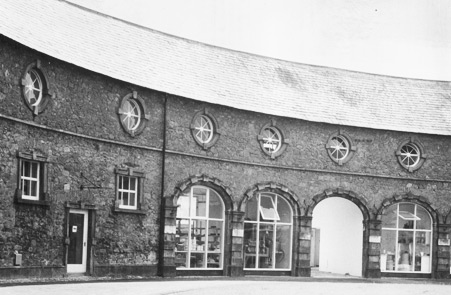
Kilkenny Design Center Workshop (courtesy RIAI )
‘I was employed by the Kilkenny Vocational Education Committee’ Kate tells me. She soon realized however, on moving to Kilkenny, that the designers associated with the Centre were a group who kept very much to themselves and did not mix with the art teachers or local people from Kilkenny at that time. Kate explains ‘There was no vibe or culture of art appreciation in Kilkenny like you would have in Montmartre in Paris for example’. It was more like ‘the valley of squinting windows’ she laughs. Kate says it was difficult to have a social life or have your own friends if you had a teaching position. So while Kilkenny may have appeared cosmopolitan in the 70s and 80s – Ireland was still Ireland in many respects. None the less Kate stayed for four years and made some lifelong friends, before returning to teach in Limerick, her native city.
Meeting Tom Muldowney
Her time in Kilkenny impacted her life in one other very important way – she met her future husband Tom Muldowney there. On a return visit 12 years after leaving her teaching post there, for an exhibition she was involved in organising, Tom introduced himself to Kate. It was a type of re-introduction actually. Kate had met Tom some years earlier when she was asked to teach art to a group from St. Kieran’s College who were sitting their Leaving Certificate. Kate laughs that she did not recognise Tom, all those years later, when he ‘gate crashed’ the opening she was having in Kilkenny in 1982 (the event was being opened by Jim Kemmy) and proceeded to chat his former teacher up! I suppose you could say the rest is history. She and Tom still live in their beautiful home in the centre of Limerick city . The house has stained glass work by Kate, a lovely tiled floor she designed and made and other installations by her.

Installation in Kate’s Backyard

Installation In Kate’s home inspired by Cambodia

Stained Glass in Kate’s home
Kate continued to teach in Limerick for 20 more years after that – in a school where conditions for teaching were far from ideal with several pupils coming from troubled and disturbed homes. She was happy to be able to leave the teaching phase of her life behind her, when, in her 50s, she focused full time on her own work and professional artistic career – and what a career it has been.
She has exhibited widely in numerous group shows such as the R.H.A, Sligo Small Works, the Oireachtas, Claremorris Open, Limerick Printmakers and Limerick City Gallery. She has also held over 30 solo shows including the Belltable, Davis Gallery Dublin, the Source Art Center Thurles, Lavitt Gallery Cork , the Air Gallery London.
In 2016 she held a solo exhibition in the Hunt Museum in Limerick. This was a particular honor as Kate had been asked by the museum in 2016 to draw some depictions from the book Irish Medieval Figure Sculpture 1200-1600 (1974) by John Hunt Sr , the legendary medievalist, and collector /dealer in artworks . John Sr was the Father of the Founder Director of the Hunt Museum in Limerick, John Jr, who died in 2004 aged 47.

The Hunt family (Courtesy: themarketquarter.ie)
Travel
‘My hobby is travel’ Kate tells me. Her travel experiences are very evident in her work.
One of her first trips abroad was in the 1960s when she went on a cattle boat to London. Today we take for granted luxury ferries crossing the Irish sea! ‘My first trips abroad were to London, Florence, and Barcelona’ Kate recounts. ‘It took two days to travel to the continent via Dunlaoghaire, Holyhead, London, Dover, Calais, Paris, Florence , now it takes two hours thanks to Ryanair’.
She loved these trips, all made by land and sea, for several decades, seeing the different cultures, tasting the food, viewing the art and designs of the cities and places she visited. I comment she is a type of anthropologist at heart too. Her first trip on an aeroplane was to Russia. Another story for another time!
The country that has arguably made the most impression on Kate was her visit in 2006 to Iran. She had an interest in Persian culture for years because when she was a student at Limerick School of Art she met a wonderful English gentleman, Stanley Barclay Russell. ‘ He was an art expert’ Kate explains ‘ and had worked in the middle East for the British Council. He bought my work and hung it in his home alongside his collection of Coptic Christian Ethiopian paintings. He said that I should visit Isfahan to enjoy the beautiful tiles and I did, after 40 years’.

Courtesy Amazon.com
Kate never forgot his advice. A few years later she spotted a book on display in the window of O Mahony’s bookshop in Limerick near where she lives. ‘It was a book called A King’s Book of Kings (1972) otherwise known as the ‘Shah Nama’, the National Epic of Iran. It was housed in a glass case in O’Mahony’s bookshop and cost £40. I paid for it in installments, but it was worth it for the beautiful Persian miniatures it contained’. Kate explains.
The second book she bought on this subject was called Persia Bridge of Turquoise (1975) by photographer Roloff Beny. This too was full of beautiful photography about Iran. Kate tells me both books were published by Thames & Hudson London and Kate later visited many of the places in these books.
Meeting the Asylum Seekers in Limerick
Times were changing once again in Ireland and the Noughties saw many people of different ethnic origin enter Ireland seeking asylum. We are all the better for that.
Kate decided to offer her skills as an art teacher to some of these people in Limerick and as she was a member of Doras Luimní, an independent non-profit organisation, working to support and promote the human rights of asylum seekers, refugees and migrants in the Limerick region through personal advocacy, integration development and advocacy campaigns at local and national level. Kate was given the green light. She managed to secure, from the Augustinians, a basement space, for 5 days a week, to open an Art studio where people trying to assimilate into Limerick, could come and do art, listen to music (they played all different nationalities – Afghanistan, Iranian, Irish, and many more there); exchange ideas about food, lifestyles music and art. This ran for 5 years from 2000 to 2005 and was a wonderful experience for Kate and all involved. She acknowledges the help and support she got from Fr. Liam Ryan with the endeavour.
Kate became good friends with people from Iran living in Limerick one of whom, Said, agreed to take her for an hour, one night a week, so she could learn Persian (Farsi) one of the predominant Iranian languages. Kate has almost 800 words and can converse in basic Farsi. Needless to say, this was all leading to a trip of a lifetime, when, in 2006 she embarked on a long tour of Iran visiting all the key sites and cities. ‘Venice is the most beautiful city in Europe’ Kate tells me ‘but Isfahan – the domes, the tiles, acres of tiles- has to be the most beautiful city in Iran’. She continues to talk to me about the geometric and flora designs that predominate here as Muslim law prohibits depicting human beings, fish or animals in artwork (other than miniatures).
Working in Different Media
Kate’s early life experiences, her student years during the turbulent changes of the 60s in Ireland, her career as teacher, and her extensive travels, have impacted profoundly on her life and artwork.
Multi skilled, she works in many different media – pen and ink, appliqué, acrylic, oils, patchwork and tiles. ‘I was always attracted by pattern and by colour’ she explains. ‘I have to say I have gone against the grain of Modernism – I love rich decoration and pattern because it is like the beats of music. It is good for the soul. Good for mine anyway. There are patterns everywhere in life’ Kate says.
I ask her to elaborate once again, as I am so engaged in this fascinating journey.
‘I believe artists must always have the freedom to create and explore new ideas. Fashions in art as well as everything else, come and go. The results are not always to my liking if they include boring videos, shock for its own sake, or conceptual art in which it seems, just having the idea is enough. Art can be political or not. We need to accept and encourage new ideas but personally I need plenty of colour design and interest to be happy. After all, I did grow up in a grey Ireland in the Fifties and Sixties, where my abiding memory as a child is of being driven home in the rain passing grey concrete unpainted houses, never even seeing a flower or flowerbed in public spaces’.
Kate Hennessy is a Pre-Raphaelite at heart – and a highly skilled artist and observer of culture.
Contact: katehessessygallery@hotmail.com

At the Opening: Mairtín O’Brien, Denise and Kate









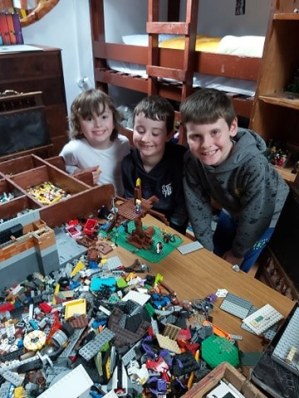








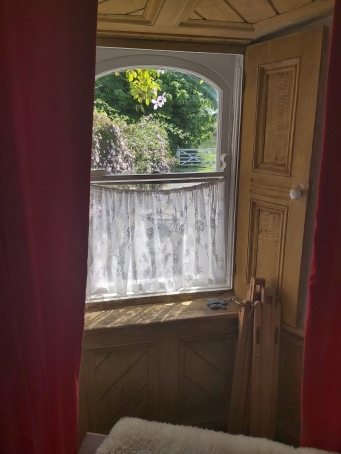









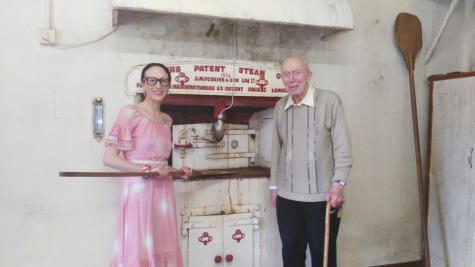


 My mind is preoccupied with questions to ask Dermot Gannon when, on Sunday, December 8th , I traveled to Clogheen near Cahir, with Seosamh and my three sons, to meet the chef and owner of ‘The Old Convent’.
My mind is preoccupied with questions to ask Dermot Gannon when, on Sunday, December 8th , I traveled to Clogheen near Cahir, with Seosamh and my three sons, to meet the chef and owner of ‘The Old Convent’.































